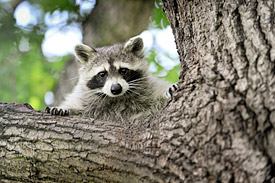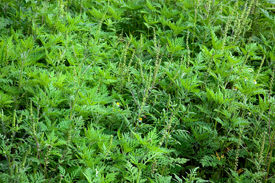Press release, 20th September 2012
Major update to Europe’s ‘alien’ species catalogue
The key catalogue of information on ‘alien’ (non-native) species in Europe has undergone a major update. The DAISIE (Delivering Alien Invasive Species Inventory for Europe) database allows the public and policymakers to get a comprehensive overview of which alien species are present in Europe, their impacts and consequences for the environment and society.
The DAISIE on-line database, which is relaunched today at the NEOBIOTA conference in Pontevedra, Spain, contains details of over 12,000 alien species. Information collated by DAISIE plays an increasingly important role in tackling the threat of alien species within Europe which has been highlighted as a priority action in policies at all levels from national to global including the Convention on Biological Diversity Strategic Plan for Biodiversity 2011-2020 (Aichi Target 9).
 The North American Raccoon (Procyon lotor) is a medium-sized mammal native to North America.
The North American Raccoon (Procyon lotor) is a medium-sized mammal native to North America.
Photo: André Künzelmann/UFZ
The DAISIE project began in 2005 with funding from the European Union and is now supported by the NERC Centre for Ecology & Hydrology in the UK in collaboration with a consortium of alien species experts from across Europe. In recent months details of over 1000 new species have been added to the database by experts from across Europe, and many other species entries have been updated with the latest information.
DAISIE contributor Dr Franz Essl, from Environment Agency Austria, said, “The DAISIE-portal has become the prime source on the state of the growing threat of biological invasions in Europe. The launch of the updated version of the DAISIE-portal providing lots of new information and new search tools makes it even more relevant – for scientists, conservation managers, and decision makers.“
DAISIE information helps in monitoring and assessing emerging threats from new arrivals, such as the northwards expansion across Europe of the Asian Hornet, and current changes in locations of the grey squirrel in Southern Europe.
DAISIE co-coordinator, Dr Helen Roy, from the NERC Centre for Ecology & Hydrology, said, “The freely available, high quality, information on the DAISIE website is key to underpinning decision-making on invasive alien species across Europe and beyond. The project is successful because a dedicated group of experts from across Europe take time to contribute, maintain and update the species information in DAISIE. This pan-European collaboration within the project is critical to addressing the threat of invasive alien species, considered one of the greatest threats to biodiversity, now and in the future.”
The DAISIE inventory currently contains details of 12177 species (986 Aquatic marine, 669 Aquatic inland, 2740 Terrestrial invertebrates, 400 Terrestrial vertebrates, 6658 Terrestrial plants, 724 Terrestrial fungi).
 Common Ragweed (Ambrosia artemisiifolia) is the most widespread plant of the genus Ambrosia in North America. Its wind-dispersed pollen is a strong allergen to many people with hay fever.
Common Ragweed (Ambrosia artemisiifolia) is the most widespread plant of the genus Ambrosia in North America. Its wind-dispersed pollen is a strong allergen to many people with hay fever.
Photo: Klaus-Dieter Sonntag/ fotoplusdesign.de
The DAISIE website is being relaunched at NEOBIOTA 2012 - Halting Biological Invasions in Europe: from Data to Decisions, the 7th European Conference on Biological Invasions, Pontevedra (Spain), 12-14 September 2012 http://neobiota2012.blogspot.co.uk/
More than 11,000 alien species were documented by DAISIE (Delivering Alien Invasive Species Inventory for Europe), a three year research project that ran from 2005 to 2008 involving more than 100 European scientists. DAISIE, originally funded by the European Union, provides new knowledge on biological invasions in Europe. Biological invasions by alien species often result in a significant loss in the economic value, biological diversity and function of invaded ecosystems.
The majority of these 12,171 alien species currently listed in the DAISIE database are not harmful. Where impacts have been assessed, around 15 % are known to cause economic damages and around 15 % are known to cause harm to biological diversity (environment, habitats and native plants, animals and micro-organisms).
What is an alien species? Alien species, also known as exotic, introduced or non-native species, are species, subspecies, or lower taxon occurring outside of the range they occupy naturally or could not occupy without direct or indirect introduction or care by humans. Although the majority of alien species cause no harm, some alien species spread very rapidly and can harm biological diversity, human health,and/or economic and esthetic values. These harmful species are called invasive alien species. More information http://www.europe-aliens.org/aboutDAISIE.do#
Further Information:
Helmholtz Centre for Environmental Research (UFZ)
Dr. Marten Winter/ Dr. Ingolf Kühn
Telefon: 0345-558-5316, -5311
http://www.ufz.de/index.php?en=7081
http://www.ufz.de/index.php?de=821
or via
Tilo Arnhold (UFZ Press Office)
Telephone: +49-341-235-1635
Links:
DAISIE (Delivering Alien Invasive Species Inventory for Europe)
At the Helmholtz Centre for Environmental Research (UFZ) scientists are researching the causes and consequences of far-reaching changes to the environment. They are concerned with water resources, biological diversity, the consequences of climate change and adaptability, environmental and biotechnologies, bioenergy, the behaviour of chemicals in the environment, their effect on health, modelling and social science issues. Their guiding theme: Our research contributes to the sustainable use of natural resources and helps to secure this basis for life over the long term under the effects of global change. The UFZ employs 1,000 people in Leipzig, Halle and Magdeburg. It is financed by the federal government and the federal states of Saxony and Saxony-Anhalt.
http://www.ufz.de/
The Helmholtz Association contributes towards solving major and pressing social, scientific and economic issues with scientific excellence in six research areas: Energy, Earth and Environment, Health, Key Technologies, Structure of Matter, Aeronautics, Aerospace and Transport. The Helmholtz Association is Germany’s largest scientific organisation with over 33,000 employees in 18 research centres and an annual budget of approximately 3.4 billion euros. Its work stands in the tradition of the naturalist Hermann von Helmholtz (1821-1894).
http://www.helmholtz.de
The Centre for Ecology & Hydrology (CEH) is the UK's Centre of Excellence for integrated research in the land and freshwater ecosystems and their interaction with the atmosphere. CEH is part of the Natural Environment Research Council, employs more than 450 people at four major sites in England, Scotland and Wales, hosts over 150 PhD students, and has an overall budget of about £35m. CEH tackles complex environmental challenges to deliver practicable solutions so that future generations can benefit from a rich and healthy environment. www.ceh.ac.uk You can follow the latest developments in CEH research via twitter www.twitter.com/CEHScienceNews and our rss news feed http://www.ceh.ac.uk/rss/rss.xml
NERC is the UK's main agency for funding and managing world-class research, training and knowledge exchange in the environmental sciences. It coordinates some of the world's most exciting research projects, tackling major issues such as climate change, food security, environmental influences on human health, the genetic make-up of life on earth, and much more. NERC receives around £300m a year from the government's science budget, which it uses to fund research and training in universities and its own research centres.
